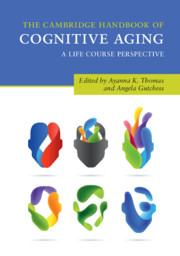Book contents
- The Cambridge Handbook of Cognitive Aging
- The Cambridge Handbook of Cognitive Aging
- Copyright page
- Contents
- Figures
- Tables
- Contributors
- Introduction
- Part I Models of Cognitive Aging
- Part II Mechanisms of Cognitive Aging
- Part III Aging in a Socioemotional Context
- Part IV Cognitive, Social, and Biological Factors across the Lifespan
- Part V Later Life and Interventions
- 32 Cerebrovascular Disease, Aging, and Depression: Clinical Features, Pathophysiology, and Treatment
- 33 The Role of Nutrition in Cognitive Decline
- 34 The Role of Sleep in Cognitive Aging
- 35 The Relationship between Accelerometer-Derived Metrics of Physical Activity and Cognition among Older Adults
- 36 Far Transfer and Cognitive Training: Examination of Two Hypotheses on Mechanisms
- 37 Maximizing the Impact of Cognitive Engagement Interventions for Older Adults
- 38 Mobility and Cognitive Decline in Older Adults with Cognitive Impairment
- 39 Current and Emerging Technologies for Supporting Successful Aging
- Part V Summary: Later Life and Interventions
- Index
- Plate Section (PDF Only)
- References
34 - The Role of Sleep in Cognitive Aging
from Part V - Later Life and Interventions
Published online by Cambridge University Press: 28 May 2020
- The Cambridge Handbook of Cognitive Aging
- The Cambridge Handbook of Cognitive Aging
- Copyright page
- Contents
- Figures
- Tables
- Contributors
- Introduction
- Part I Models of Cognitive Aging
- Part II Mechanisms of Cognitive Aging
- Part III Aging in a Socioemotional Context
- Part IV Cognitive, Social, and Biological Factors across the Lifespan
- Part V Later Life and Interventions
- 32 Cerebrovascular Disease, Aging, and Depression: Clinical Features, Pathophysiology, and Treatment
- 33 The Role of Nutrition in Cognitive Decline
- 34 The Role of Sleep in Cognitive Aging
- 35 The Relationship between Accelerometer-Derived Metrics of Physical Activity and Cognition among Older Adults
- 36 Far Transfer and Cognitive Training: Examination of Two Hypotheses on Mechanisms
- 37 Maximizing the Impact of Cognitive Engagement Interventions for Older Adults
- 38 Mobility and Cognitive Decline in Older Adults with Cognitive Impairment
- 39 Current and Emerging Technologies for Supporting Successful Aging
- Part V Summary: Later Life and Interventions
- Index
- Plate Section (PDF Only)
- References
Summary
Aging is marked by cognitive decline, which in the case of Alzheimer’s disease is associated with tremendous global economic burden. Identifying modifiable risk factors for cognitive decline is therefore of paramount importance. In this chapter, we describe how aging compromises sleep quality and sleep architecture at a rate that parallels normal age-related cognitive decline. We argue that understanding the neurocognitive functions of sleep – frontal lobe restoration, memory consolidation, and metabolite clearance – and how such functions change in later life will be key to informing why some older individuals maintain healthy cognitive functioning and other older individuals do not. Critically, by investigating how sleep, cognition, and aging interact, researchers and clinicians can develop sleep-related treatments that target preventing, or at least ameliorating, pathologies such as Alzheimer’s disease.
Keywords
- Type
- Chapter
- Information
- The Cambridge Handbook of Cognitive AgingA Life Course Perspective, pp. 628 - 644Publisher: Cambridge University PressPrint publication year: 2020
References
- 2
- Cited by

